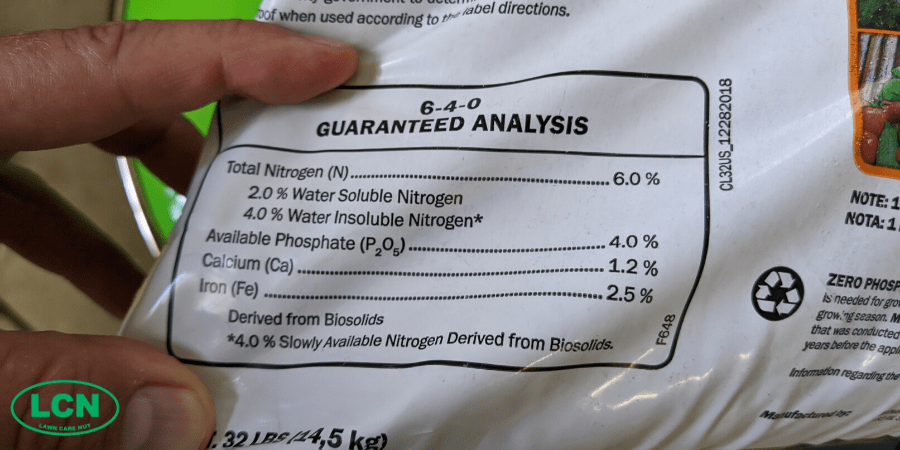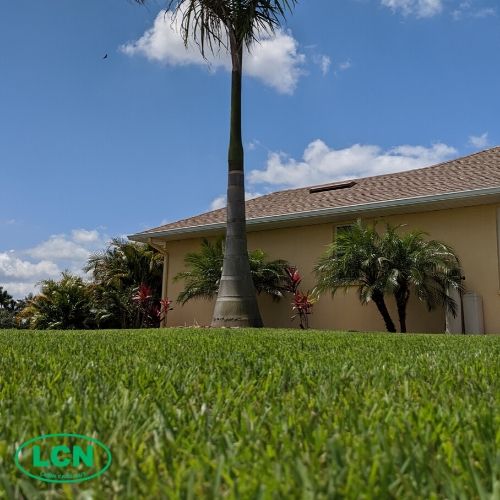What Makes Grass Green?
- "The Lawn Care Nut"May 16, 2020
When setting out to have a nice lawn, there are 3 basic key performance indicators that will keep you encouraged and moving forward. Those being:
- Less Weeds
- Greener Lawn/Improved Color
- Thicker Turf Overall
Every homeowner puts a different emphasis on each but in today’s post, I’m going to focus on that green color. The reason being is that along with adding the nutrients it takes to improve the color, the thickness of the turf follows along with it.
Nitrogen Drives The Bus
The number one way to increase the green color in your lawn is with Nitrogen. Nitrogen is one of the big three macronutrients needed in the greatest quantities for healthy turf. It promotes top growth in the lawn by pushing the production of chlorophyll in the plant. More green top growth means the plant can grab more sunlight for photosynthesis. Photosynthesis is how plants make their own “food” which is used to produce more roots. More roots mean more support for more top growth ongoing, which makes the lawn thicker over time.
When you look at bags of lawn fertilizer, you see 3 numbers. This is called the “analysis.”
With Milorganite, those numbers are 6-4-0.
The first number there, 6, represents nitrogen which means that 6% of everything in the bag is nitrogen. Milo’s nitrogen is naturally slow releasing which gives you the confidence to know it will not burn the lawn, but it’s also better for the grass plants as they get the feed coming over time, rather than flushed in all at once, which can shock the lawn.
Because it’s a natural source of nitrogen, it works better in hot weather so it makes a great late spring and summer application. Microbes in the soil also benefit from Milo applications which means it not only turns the lawn green, but it improves your soil structure at the same time.

If you flip the bag over and read the label, you can see the concentrations of elements contained in Milorganite. Notice the 2.5% iron content especially.
Iron Turns It Blue-Green
While nitrogen drives the bus, iron gives it another gear to push the color deeper. Iron is a micronutrient grass plants need. It isn’t one of the “big 3” but instead, plays a supporting role to them, nitrogen especially.
Iron helps in the production of chlorophyll and nutrient and oxygen transport throughout the plant but for you and me, looking for the visuals, it pushes a deeper, darker blue-green color.
Milorganite has higher iron content compared to most fertilizers on the shelf. I usually see them come in around 1-1.5% iron but Milo is 2.5% and sometimes more. Here is a quote from my friend Jeff Spence. Jeff is the Director of Sales and Marketing for MMSD:
“The nutrient value of Iron will vary in Milorganite, based on the wastewater treatment operations at any point in time. The Milorganite product specification of 2.5% is based on a minimum value observed in Milwaukee’s systems. The value of Iron in Milorganite can at times exceed 4%.”
So while you are guaranteed at least 2.5%, you could sometimes get more.
The Secret Is In The Prills
One of the unique features of Milo is that it is a “homogeneous” fertilizer source. This means that every prill or granule contains the entire analysis.
This is in contrast to “blended” fertilizers which keep the components separate. What this means is you get a much more consistent application with Milo, even if you are new and just starting out. And once again, I want to reiterate, no fear of burning the lawn.

On the left is Milorganite. Notice that every prill is the same color indicating it's a homogenous fertilizer. Every prill contains the entire analysis. On the right is a box store fertilizer and is blended. Each color of prill represents a different nutrient.
Grass Type Matters
Now that you know how to get your lawn nice and green, I want to caution you about comparisons, especially online.
Oftentimes I get emails from folks who are looking at lawns on Instagram and they ask “how come I can’t get my lawn as green as that?”
Photo filters and perfect lighting aside, usually it’s someone who lives down south looking at someone posting pics of a Kentucky Bluegrass lawn up north. So let’s start there.
Generally speaking, Kentucky Bluegrass will have the deepest, darkest bluegreen color of any grass you compare it to just by its very nature. Some of the newer improved varieties are even darker than the “old school” stuff that you find in many older lawns. After all, it’s in the name so it makes sense right?
Turf Type Tall fescue, another cool-season turfgrass, is also able to get very dark blue-green and some of the newest varieties there have been bred to compete with KBG in color.
From there, it begins to fall off a bit. Perennial rye, the third most common cool-season grass, can get a nice green color, and probably has somewhere around the same overall color as new Zoysia and Hybrid Bermuda varieties.
St Augstinegrass, which we find mostly in Texas and Florida, can get dark green, but just won’t sustain the deeper darker color that KBG will, not even close. And our friend Centipede comes in last place with more of a lime color, right from the start.
Does this mean that one grass type is superior to another? No.
It’s just nature, and as the great American singer songwriter Stephen Stills reminds, “Love The One You’re With.”
Now as soon as I write this, there will be 100 emails come in from folks who have these grass types and they are super duper dark blue-green. I know because I’ve seen them, and that is great! Please keep in mind, I am speaking here in broad sweeping generalities so as to try and set your expectations right.
The last thing I want you to do is keep throwing down over label rates trying to make your St Augustine as blue-green as your KBG was up north. This isn’t the way to go!

Here is my zoysia lawn. It's very green and much greener than every other zoysia lawn in my neighborhood, but it isn't ever going to reach the same blue green color that my Turf Type Tall fescue did up north.
But I can give you an exception right now. I have a new cultivar of St Augustine called “ProVista” that has been genetically modified and “injected” with DNA from spinach and because of that, it has a nice bluegreen color when I hit it with Milo. It holds sometimes for weeks too.
But what I am really trying to get at here is, if you are going to compare the color of your lawn to others, compare to those right around you, in the same neighborhood. Likely you all will have similar grass types and therefore you can use the Milo N and Fe to show off locally, instead of nationally, on Instagram. Ha!
In short, if you want the greenest, deepest blue green lawn you can get this late spring and summer, throw down some Milo and let that color work it’s way in and through. If you have friends coming over for a party and want to show the color off to them, be sure to apply about 10 days before the party. You should be at peak color blast by then!
I hope this blog post has been helpful to you, and I’ll see you in the lawn!

